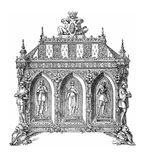
Black Is the Color
GUEST COLUMN
We can learn much through contrasts — the opposite of a given phenomenon can say and teach much about the original. Such was the case with my being recently honored with concelebrating at the Funeral Mass of a layman friend, offered at a parish noted for its passionate fidelity to the Catholic Faith.
A most powerful element of this Mass, one which reflected a staunch courage on the part of the pastor, and the parish’s sound understanding of crucial doctrinal principles of the Faith, was the choice of the color of the priestly liturgical vestments worn. That color was black. Although this would’ve been perfectly normal a half-century ago, today it is de rigueur to use white vestments. In our culture, black is the definitively somber color — the color that compels one toward sobriety, and from which one is hardly able to escape an eschatological frame of mind. The traditional color of clerical garb of diocesan priests is black, and for the same reasons. In pre-Vatican II times, it was even customary for such priests to drive black cars. In short, black helps induce a sense of penitential recollection — remembering that “here we do not have a lasting city” (Heb. 13:14), but that everything in our earthly lives should contribute to our striving toward the New Jerusalem, our divinely intended home. The faithful in attendance, relatives and good friends of the deceased, were of the same frame of mind, and were there to beseech our Lord for mercy on this man’s soul.
However, assisting in a typical Funeral Mass at an average parish is usually a completely different experience. An objective perspective of such a Mass would lead one to believe one were witnessing an impromptu “canonization.” Never mind the exhaustive and extensive process whereby Holy Mother Church examines the minutiae of a potential saint’s life — the present-day Funeral Mass is filled with assuring indicators that the departed is positively guaranteed of Heaven. One begins to wonder why a Mass is offered to begin with — evidently being more out of thanksgiving that yet another soul has immediately entered into glory, having finished with the travails of this earthly life. The choir’s jubilant “Alleluias,” the careful selections of readings that convey or imply more certainty than mere hope of immediate salvation, homilies that leave no doubt as to the departed’s perfect sinlessness — all contribute to expunging any sense of doubt as to the soul’s new address in the mind of the average layman. All of this in the context of a Church in which the rate of contraception use is reported to be at least 85 percent, where, given the now-established links between abortion and breast cancer, and between oral contraceptives and reproductive organ cancers, many women die at early ages of these cancers, and where at the same time the lines outside confessionals are short to non-existent.
You May Also Enjoy
When the Church stripped the liturgy of its grandeur, she cheapened the meaning of priesthood and is now reaping a predictably poor harvest.
The charismatic quest for paranormal experiences of God is also a contrived pseudo-communion of ecstatic emotional dissolution.
The Hebrew-ness of Catholicism is a critical element of it. When we excise Hebrew elements from our prayers, we sever roots that feed our religion.

